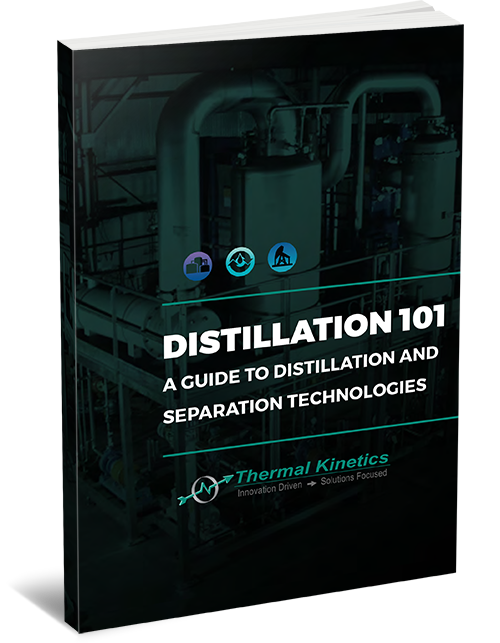What You Need to Know About Distillation
Distillation is an essential separation process used across a broad range of sectors including the food and beverage, petrochemical, specialty chemicals, pharmaceutical, water treatment, and agriculture industries. Distillation involves separating two or more components or substances from a liquid mixture based on the variance in their boiling points. Depending on the industry, the distillation process can be used to perform several operations including concentration enhancement, purification, devolatilization, and resource recovery.
Below are some of the distillation equipment, technologies, and processes that are currently being leveraged across industries.
Single Stage & Multiple Stage Technologies
Distillation processes are typically done in single or multiple stages. Single-stage thermal distillation is a continuous operation where a liquid mixture is fully or partially vaporized in one single phase. The solution is heated to its boiling point, causing the more volatile components to evaporate, where it is subsequently cooled and condensed. In multi-stage distillation, portions of the liquid are vaporized and cooled/condensed in successive stages, usually with decreasing pressure and temperature.
In another type of separation technique, known as scrubbing, volatile components in a gaseous phase contact and combine with a counterflowing liquid via absorption. Molecular sieve dehydration is another well-known separation method and uses a system of sieves that allows the molecules of a particular substance to fit into its pores, where it adheres to the sieve; this process is called adsorption. Molecular sieve dehydration is typically used after alcohol/ethanol distillation.
Distillation Basics
All distillation processes, regardless of the technologies employed, operate by exploiting the differences in the volatility of a mixture’s various components. This volatility is related to a compound’s vapor pressure or boiling point. The boiling point of a liquid is directly proportional to the applied external pressure. For instance, at 14.7 psia, water will boil at 212oF; however, at 1.94 psia, the boiling point changes to 125oF. The variance in vapor pressures and boiling points between liquids are referred to as relative volatility. The distribution coefficient is another critical component of distillation and is related to the composition and concentration of the vapor in equilibrium with the liquid mixture.
Design Procedures
The distillation process, though relatively simple in concept, requires careful analysis and meticulous calculations to ensure its success and efficiency at an industrial scale. Over the years, several calculation procedures, equations, diagrams, and mathematical models have been developed to represent the various stages of the process.
One of several design methods presented in our eBook is the McCabe-Thiele Diagram. This graphical method is commonly used to determine the ideal number of stages and the location of feed trays for a particular distillation process. To ensure the efficiency of the distillation process, all design procedures must consider a number of factors including:
- Calculation of the number of equilibrium stages
- Determination of tray hydraulics
- Selection of tray or packing efficiencies
Equipment Components of the Distillation System
Distillation systems consist of numerous components; with each playing a different role in the process. In our eBook, we look at the various elements of several distillation systems and describe the factors that influence their design. Some of the components we cover include:
- Contacting equipment
- Sieve tray
- Valve tray
- Bubble cap tray
- Dual-flow tray
- Packing
- Downcomer design
- Columns
- Feed distribution and redistribution systems
- Column intervals
Conclusion
The team at Thermal Kinetics has recently released their new eBook, “Distillation 101 a Guide to Distillation and Separation Technologies”. This publication gives an in-depth look at the distillation process and its various elements, including:
- Distillation design procedures
- Distillation equipment and essential components
- Industrial applications
If you would like to dive deeper into the distillation process, click here to download our free eBook.



 Our involvement included preparation of the processing plant’s material and energy balance, design layout of all major equipment from receipt of raw ore, ore dissolving, purification, clarification, crystallization, centrifugation, and drying operations.
Our involvement included preparation of the processing plant’s material and energy balance, design layout of all major equipment from receipt of raw ore, ore dissolving, purification, clarification, crystallization, centrifugation, and drying operations. It was a mind boggling gathering of the best and brightest executives in the renewables sector. The hot topic was low cost oil, but most remain steadfast on their chosen path, although financing may be even tougher to land. This most interesting article speaks directly to the impact of oil prices and an emerging industry that remains resolute.
It was a mind boggling gathering of the best and brightest executives in the renewables sector. The hot topic was low cost oil, but most remain steadfast on their chosen path, although financing may be even tougher to land. This most interesting article speaks directly to the impact of oil prices and an emerging industry that remains resolute.